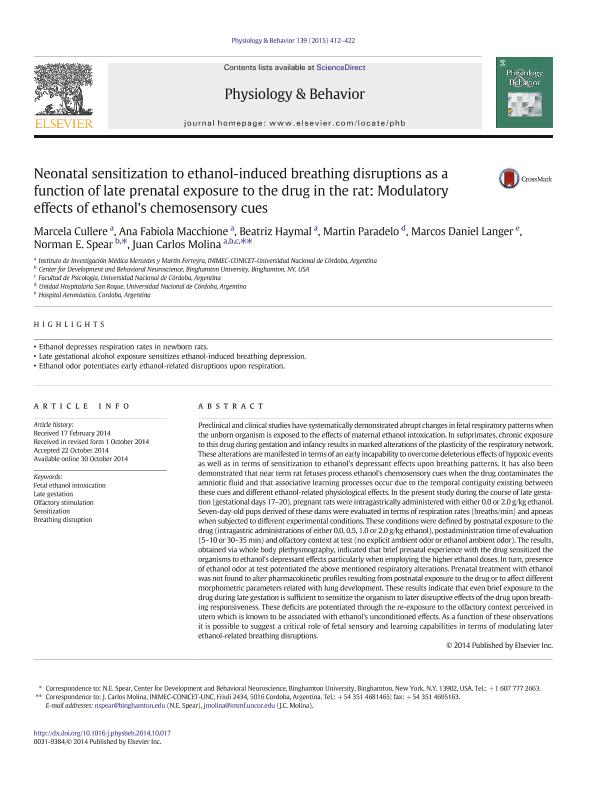Mostrar el registro sencillo del ítem
dc.contributor.author
Culleré, Marcela Elena

dc.contributor.author
Macchione, Ana Fabiola

dc.contributor.author
Haymal, Olga Beatriz

dc.contributor.author
Paradelo, Martin
dc.contributor.author
Langer, Marcos Daniel
dc.contributor.author
Spear, Norman E.
dc.contributor.author
Molina, Juan Carlos

dc.date.available
2018-03-22T16:42:15Z
dc.date.issued
2015-02
dc.identifier.citation
Culleré, Marcela Elena; Macchione, Ana Fabiola; Haymal, Olga Beatriz; Paradelo, Martin; Langer, Marcos Daniel; et al.; Neonatal sensitization to ethanol-induced breathing disruptions as a function of late prenatal exposure to the drug in the rat: Modulatory effects of ethanol's chemosensory cues; Pergamon-Elsevier Science Ltd; Physiology And Behavior; 139; 2-2015; 412-422
dc.identifier.issn
0031-9384
dc.identifier.uri
http://hdl.handle.net/11336/39675
dc.description.abstract
Preclinical and clinical studies have systematically demonstrated abrupt changes in fetal respiratory patterns when the unborn organism is exposed to the effects of maternal ethanol intoxication. In subprimates, chronic exposure to this drug during gestation and infancy results in marked alterations of the plasticity of the respiratory network. These alterations are manifested in terms of an early incapability to overcome deleterious effects of hypoxic events as well as in terms of sensitization to ethanol's depressant effects upon breathing patterns. It has also been demonstrated that near term rat fetuses process ethanol's chemosensory cues when the drug contaminates the amniotic fluid and that associative learning processes occur due to the temporal contiguity existing between these cues and different ethanol-related physiological effects. In the present study during the course of late gestation (gestational days 17-20), pregnant rats were intragastrically administered with either 0.0 or 2.0. g/kg ethanol. Seven-day-old pups derived of these dams were evaluated in terms of respiration rates (breaths/min) and apneas when subjected to different experimental conditions. These conditions were defined by postnatal exposure to the drug (intragastric administrations of either 0.0, 0.5, 1.0 or 2.0. g/kg ethanol), postadministration time of evaluation (5-10 or 30-35. min) and olfactory context at test (no explicit ambient odor or ethanol ambient odor). The results, obtained via whole body plethysmography, indicated that brief prenatal experience with the drug sensitized the organisms to ethanol's depressant effects particularly when employing the higher ethanol doses. In turn, presence of ethanol odor at test potentiated the above mentioned respiratory alterations. Prenatal treatment with ethanol was not found to alter pharmacokinetic profiles resulting from postnatal exposure to the drug or to affect different morphometric parameters related with lung development. These results indicate that even brief exposure to the drug during late gestation is sufficient to sensitize the organism to later disruptive effects of the drug upon breathing responsiveness. These deficits are potentiated through the re-exposure to the olfactory context perceived in utero which is known to be associated with ethanol's unconditioned effects. As a function of these observations it is possible to suggest a critical role of fetal sensory and learning capabilities in terms of modulating later ethanol-related breathing disruptions.
dc.format
application/pdf
dc.language.iso
eng
dc.publisher
Pergamon-Elsevier Science Ltd

dc.rights
info:eu-repo/semantics/openAccess
dc.rights.uri
https://creativecommons.org/licenses/by-nc-nd/2.5/ar/
dc.subject
Breathing Disruption
dc.subject
Fetal Ethanol Intoxication
dc.subject
Late Gestation
dc.subject
Olfactory Stimulation
dc.subject
Sensitization
dc.subject.classification
Neurociencias

dc.subject.classification
Medicina Básica

dc.subject.classification
CIENCIAS MÉDICAS Y DE LA SALUD

dc.title
Neonatal sensitization to ethanol-induced breathing disruptions as a function of late prenatal exposure to the drug in the rat: Modulatory effects of ethanol's chemosensory cues
dc.type
info:eu-repo/semantics/article
dc.type
info:ar-repo/semantics/artículo
dc.type
info:eu-repo/semantics/publishedVersion
dc.date.updated
2018-03-22T13:05:34Z
dc.journal.volume
139
dc.journal.pagination
412-422
dc.journal.pais
Estados Unidos

dc.description.fil
Fil: Culleré, Marcela Elena. Consejo Nacional de Investigaciones Científicas y Técnicas. Centro Científico Tecnológico Conicet - Córdoba. Instituto de Investigación Médica Mercedes y Martín Ferreyra. Universidad Nacional de Córdoba. Instituto de Investigación Médica Mercedes y Martín Ferreyra; Argentina
dc.description.fil
Fil: Macchione, Ana Fabiola. Consejo Nacional de Investigaciones Científicas y Técnicas. Centro Científico Tecnológico Conicet - Córdoba. Instituto de Investigación Médica Mercedes y Martín Ferreyra. Universidad Nacional de Córdoba. Instituto de Investigación Médica Mercedes y Martín Ferreyra; Argentina
dc.description.fil
Fil: Haymal, Olga Beatriz. Consejo Nacional de Investigaciones Científicas y Técnicas. Centro Científico Tecnológico Conicet - Córdoba. Instituto de Investigación Médica Mercedes y Martín Ferreyra. Universidad Nacional de Córdoba. Instituto de Investigación Médica Mercedes y Martín Ferreyra; Argentina
dc.description.fil
Fil: Paradelo, Martin. Universidad Nacional de Córdoba. Unidad Hospitalaria "San Roque"; Argentina
dc.description.fil
Fil: Langer, Marcos Daniel. Fuerza Aérea Argentina. Hospital Aeronáutico Córdoba; Argentina
dc.description.fil
Fil: Spear, Norman E.. University Of Binghamton; Estados Unidos
dc.description.fil
Fil: Molina, Juan Carlos. University Of Binghamton; Estados Unidos. Consejo Nacional de Investigaciones Científicas y Técnicas. Centro Científico Tecnológico Conicet - Córdoba. Instituto de Investigación Médica Mercedes y Martín Ferreyra. Universidad Nacional de Córdoba. Instituto de Investigación Médica Mercedes y Martín Ferreyra; Argentina. Universidad Nacional de Córdoba. Facultad de Psicología; Argentina
dc.journal.title
Physiology And Behavior

dc.relation.alternativeid
info:eu-repo/semantics/altIdentifier/doi/http://dx.doi.org/10.1016/j.physbeh.2014.10.017
dc.relation.alternativeid
info:eu-repo/semantics/altIdentifier/url/https://www.sciencedirect.com/science/article/pii/S0031938414004934
Archivos asociados
